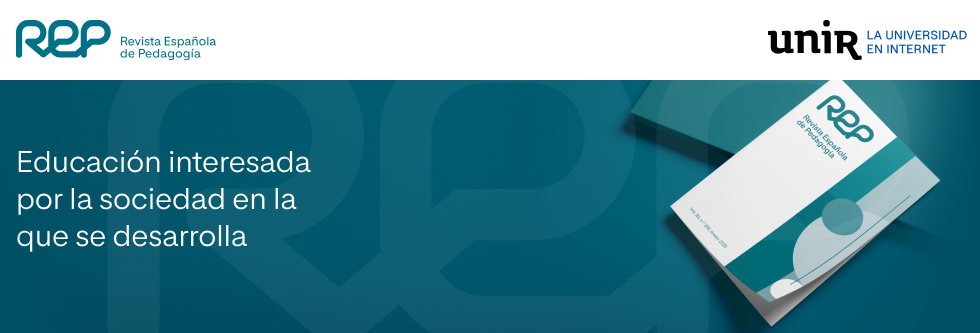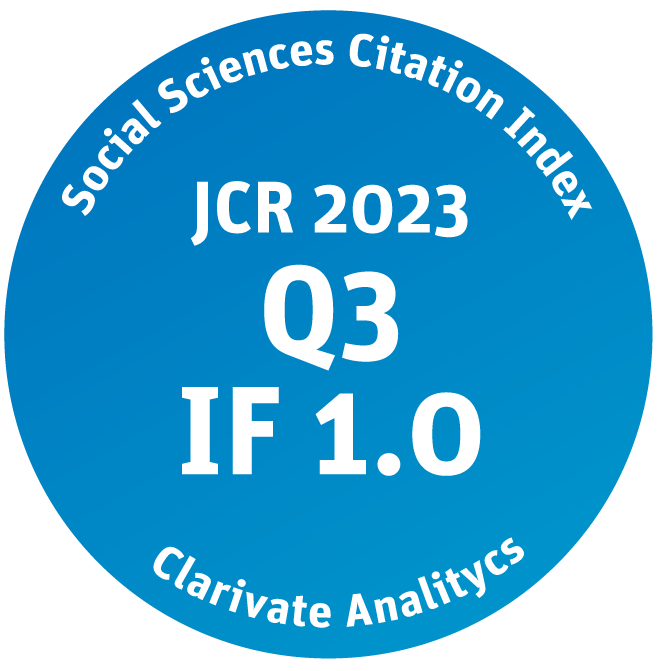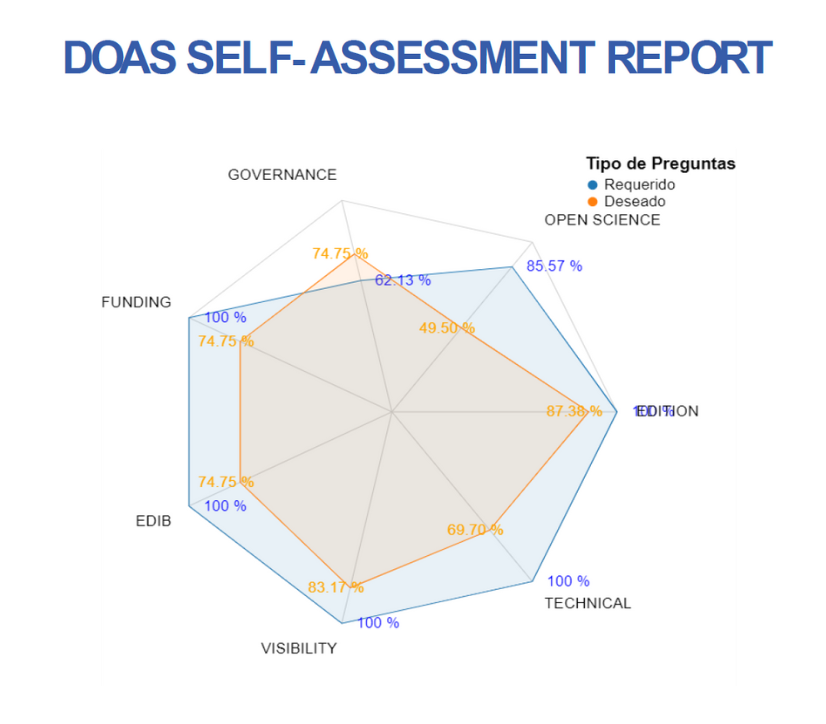La escala de los dominios de creatividad de Kaufman: validación en un contexto universitario español
DOI
10.22550/2174-0909.4041
Abstract
Creativity is understood to be a set of elements that define a creative person, and the Kaufman Domains of Creativity Scale is internationally regarded as being of scientific value for measuring it. This article verifies the applicability of this instrument in a Spanish university context, after having its 50 elements professionally translated into Spanish and conducting an empirical study that establishes its guarantees of reliability and validity in this scenario. Following analytical exploration of this tool’s constituent factors, the original five domains (everyday, performance, academic, mechanical/ scientific, and artistic) are restructured into eight (everyday, performance, mechanical/scientific, academic, artistic expression, artistic understanding, emotional, and mathematical). As in other international settings, students were found to give statistical validity to basic social skills, while artistic competences, scientific design strategies, and intellectual capacities are constants within the construct of creativity regardless of the population group being studied. Nonetheless, the distinguishing features are in the artistic domain, which has undergone division, giving prominence to artistic expression and understanding of the arts. Also, in the extraction of an emotional component that goes beyond the everyday, and in a purely mathematical domain disaggregated from the mechanical/scientific domain.
Referencias | References
Aranguren, M., & Irrazabal, N. (2012). Diseño de una escala para la evaluación del comportamiento creativo en diferentes dominios [A scale for the evaluation of creativity behavior in different domains: Development and design]. Ciencias Psicológicas, 6 (1), 29-41. https://doi.org/10.22235/cp.v6i1.60
Awofala, A. O., & Fatade, A. O. (2017). Validación de una escala sobre dominios de creatividad para futuros profesores de ciencias naturales, tecnología y matemáticas [Validation of the domains of creativity scale for Nigerian preservice science, technology, and mathematics teachers]. Electronic Journal of Research in Education Psychology, 13 (35), 131-150. https://doi.org/10.14204/ejrep.35.14057
Baer, J. (2011). Domains of creativity. In M. Runco y S. Pritzker (Eds.), Encyclopedia of creativity (pp. 377-382). Elsevier.
Batey, M. (2007). A psychometric investigation of everyday creativity [Doctoral Dissertation]. University College.
Beghetto, R. A., & Kaufman, J. C. (2007). Toward a broader conception of creativity: A case for mini-c creativity. Psychology of Aesthetics, Creativity, and the Arts, 1 (2), 73-79. https://doi.org/10.1037/1931-3896.1.2.73
Bermejo, R., & Ruiz, M. J. (2017). Los desafíos de la investigación sobre la especificidad o generalidad de la creatividad [Challenges of research on the specificity or generality of creativity]. In L. S. Almeida (Coord.), Criatividade e pensamento crítico: conceit, avaliação e desenvolvimento [Creativity and critical thinking: Concept, evaluation and development] (pp. 75-106). CERPSI. Brauer, K., Sendatzki, R., Kaufman, J. C., & Proyer, R. T. (2022). Counting the muses in German speakers: Evaluation of the German-language translation of the Kaufman domains of creativity scales (K-DOCS). Psychological Test Adaptation and Development, 3 (1), 70-84. https://doi.org/10.1027/2698-1866/a000024
Carson, S., Peterson, J. B., & Higgins, D. M. (2005). Reliability, validity and factor structure of the creative achievement questionnaire. Creativity Research Journal, 17 (1), 37-50. https://doi.org/10.1207/s15326934crj1701_4
Corbalán, J. (2008). ¿De qué se habla cuando hablamos de creatividad? [What do we mean when we talk about creativity?]. Cuadernos de la Facultad de Humanidades y Ciencias Sociales, 35, 11-21.
Corbalán, F. J., Martínez, F., Donolo, D. S., Alonso, C., Tejerina, M., & Limiñana, R. M. (2003). CREA. Inteligencia creativa. Una medida cognitiva de la creatividad [CREA. Creative intelligence. A cognitive measure of creativity]. TEA Ediciones.
Delgado, B., Martínez, M. C., Rodríguez, J. R., & Escortell, R. (2019). La autoeficacia académica y la inteligencia emocional como factores asociados al éxito académico de los estudiantes universitarios [Academic self-efficacy and emotional intelligence as factors associated with the academic success of university students]. Gestión de las Personas y Tecnología, 12 (35), 46-60.
Diedrich, J., Jauk, E., Silvia, P. J., Gredlein, J. M., Neubauer, A. C., & Benedek, M. (2018). Assessment of real-life creativity: The inventory of creative activities and achievements (ICAA). Psychology of Aesthetics, Creativity, and the Arts, 12 (3), 304-316. https://doi.org/10.1037/aca0000137
Elisondo, R., & Donolo, D. (2016). Construcción y análisis de las propiedades psicométricas del cuestionario de acciones creativas en población argentina [Construction and analysis of the psychometric properties of the creative actions questionnaire in Argentinean population]. PSIENCIA. Revista Latinoamericana de Ciencia Psicológica, 8 (1), 1-21.
Elisondo, R. C., & Donolo, D. S. (2021). Cuestionario de acciones creativas: propiedades psicométricas de la versión abreviada (CAC42) [Creative actions questionnaire: Psychometric properties of the abbreviated version (CAC42)]. Revista Evaluar, 21 (3), 81-94. https://doi.org/10.35670/1667-4545.v21.n3.36308
Faletič, L., & Avsec, A. (2019). Validation of the Slovene form of Kaufman domains of creativity scale. Psiholoska Obzorja, 28, 40-52. https://doi.org/10.20419/2019.28.499
García, E., Gil, J., & Rodríguez, G. (2000). Análisis factorial [Factor analysis]. La Muralla/Hespérides.
Gardner, H. (1994). Educación artística y desarrollo humano [Arts education and human development]. Paidós Ibérica.
Gibim, Q. G., & Wechsler, S. M. (2020). Escala de perfil criativo, construção e estudos psicométricos [Creative profile scale: Test construction and psychometrics studies]. Avaliação Psicológica, 19 (4), 382-389.
Hernández-Sampieri, R., & Mendoza, C. P. (2018). Metodología de la investigación. Las rutas cuantitativa, cualitativa y mixta [Research methodology. Quantitative, qualitative and mixed routes]. McGraw-Hill.
Hocevar, D. (1979, 16-19 de abril). The development of the creative behavior inventory (CBI) [paper]. Annual meeting of the Rocky Mountain Psychological Association, Las Vegas (EE. UU.).
Huang, P.-S., Peng, Sh.-L., Chen, H.-Ch., Tseng, L.- Ch., & Hsu, L.-Ch. (2017). The relative influences of domain knowledge and domain-general divergent thinking on scientific creativity and mathematical creativity. Thinking Skills and Creativity, 25, 1-9. https://doi.org/10.1016/j.tsc.2017.06.001
Ivcevic, Z. (2007). Artistic and everyday creativity: An act-frequency approach. Journal of Creative Behavior, 41 (4), 271-290. https://doi.org/10.1002/j.2162-6057.2007.tb01074.x
Ivcevic, Z., & Mayer, J. D. (2009). Mapping dimensions of creativity in the life-space. Creativity Research Journal, 21 (2-3), 152-165. https://doi.org/10.1080/10400410902855259
Julmi, C., & Scherm, E. (2016). Measuring the domain-specificity of creativity. University of Hagen. https://www.fernuni-hagen.de/wirtschaftswissenschaft/download/beitraege/db-502.pdf
Kandemir, M. A., & Kaufman, J. C. (2020). The Kaufman domains of creativity scale: Turkish validation and relationship to academic major. Journal of Creative Behavior, 54 (4), 1002-1012. https://doi.org/10.1002/jocb.428
Kapoor, H., Reiter-Palmon, R., & Kaufman, J..C (2021). Norming the muses: Establishing the psychometric properties of the Kaufman domains of creativity scale. Revista de Evaluación Psicoeducativa, 39 (6), 680-693. https://doi.org/10.1177/07342829211008334
Karwowski, M., & Beghetto, R. A. (2019). Creative behavior as agentic action. Psychology of Aesthetics, Creativity, and the Arts, 13 (4), 402-415. https://doi.org/10.1037/aca0000190
Kaufman, J. C. (2012). Counting the muses: Development of the Kaufman domains of creativity scale (K-DOCS). Psychology of Aesthetics, Creativity, and the Arts, 6 (4), 298-308. https://doi.org/10.1037/a0029751
Kaufman, J. C., & Baer, J. (2004). Sure, I’m creative but not in mathematics! Self-reported creativity in diverse domains. Empirical Studies of the Arts, 22 (2), 143-155. https://doi.org/10.2190/26HQ-VHE8-GTLN-BJJM
Kaufman, J. C., & Baer, J. (2005). The amusement park theory of creativity. In J. C. Kaufman, & J. Baer (Eds.), Creativity across domains: Faces of the muse (pp. 321-328). Erlbaum.
Kaufman, J. C., & Beghetto, R. A. (2009). Beyond big and little: The four C model of creativity. Review of General Psychology, 13, 1-12. https://doi.org/10.1037/a0013688
Kaufman, J. C., Cole, J. C., & Baer, J. (2009). The construct of creativity: A structural model for self-reported creativity ratings. Journal of Creative Behavior, 43 (2), 119-134. https://doi.org/10.1002/j.2162-6057.2009.tb01310.x
McKay, A. S., Karwowski, M., & Kaufman, J. C. (2017). Measuring the muses: Validating the Kaufman domains of creativity scale (K-DOCS). Psychology of Aesthetics, Creativity, and the Arts, 11 (2), 216-230. https://doi.org/10.1037/aca0000074
Miroshnik, K. G., Shcherbakova, O. V., & Kaufman, J. C. (2022). Kaufman domains of creativity scale: Relationship to occupation and measurement invariance across gender. Creativity Research Journal, 34 (2), 159-177. https://doi.org/10.1080/10400419.2021.1953823
Plucker, J. A., & Beghetto, R. A. (2004). Why creativity is domain general, why it looks domain specific and why the distinction does not matter. In R. J. Sternberg, E. L. Grigorenko, & J. L. Singer (Eds.), Creativity. From potential to realization (pp. 153-168). American Psychological Association.
Romo, M., Sánchez-Ruiz, M. J., & Alfonso-Benlliure, V. (2017). Creatividad y personalidad a través de dominios: una revisión crítica [Creativity and personality across domains: A critical review]. Anuario de Psicología, 47 (2), 57-69. https://doi.org/10.1016/j.anpsic.2017.04.003
Sánchez, L., Escalante, S., Martínez, A., & Zurita-Ortega, F. (2023). Inteligencia emocional en el perfil formativo y psicosocial de los estudiantes universitarios: una revisión sistemática [Emotional intelligence in the formative and psychosocial profile of university students: a systematic review]. Educatio Siglo XXI, 41 (2), 147-164. https://doi.org/10.6018/educatio.515181
Sternberg, R. J. (2009). Domain-generality versus domain-specificity of creativity. In P. Meusburger, J. Funke, & E. Wunder (Eds.), Milieus of creativity (pp. 25-38). Springer.
Susanto, E., Novitasari, Y., Rakhmat, C., Hidayat, A., & Wibowo, S. B. (2018). Rash model analysis of Kaufman domains of creativity scale (K-DOCS) to Indonesian students. Journal of Physics: conference series, 1114 (1), 012027. https://ui.adsabs.harvard.edu/link_gateway/2018JPhCS1114a2027S/doi:10.1088/1742-6596/1114/1/012027
Tu, C., Guo, J., Hatcher, R. C., & Kaufman, J. C. (2020). The relationship between emotional intelligence and domain-specific and domain-general creativity. The Journal of Creative Behavior, 54 (2), 337-349. https://doi.org/10.1002/jocb.369
Xu, X., Liu, W., & Pang, W. (2019). Are emotionally intelligent people more creative? A meta-analysis of the emotional intelligence-creativity link. Sustainability, 11 (21), 6123. https://doi.org/10.3390/su11216123
Citación recomendada | Recommended citation
González-López, I., Martín-Fernández, M. A., & Moral-Martín, P. (2024). The Kaufman domains of creativity scale: Validation in a Spanish university context [La escala de los dominios de creatividad de Kaufman: validación en un contexto universitario español]. Revista Española de Pedagogía, 82 (288), 221-241. https://doi.org/10.22550/2174-0909.4041
Licencia Creative Commons | Creative Commons License
Esta obra está bajo una licencia internacional Creative Commons Atribución-NoComercial 4.0.
This work is licensed under a Creative Commons Attribution-NonCommercial 4.0 International License
Palabras clave | Keywords
creativity domains, reliability, validity, factor analysis, Spanish university students








